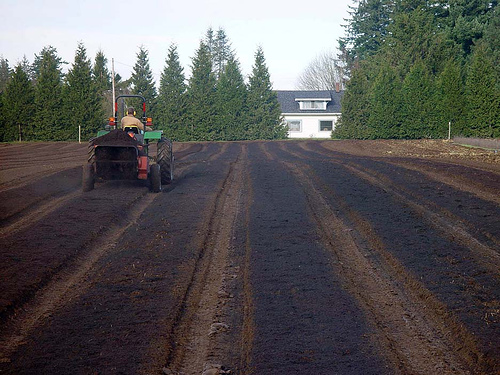Learning to use wood charcoal in farming
- Log in to post comments
Learning to use wood charcoal in farming at a Northwestern Washington native plant nursery.
Richard Haard, Fourth Corner Nurseries, Washington, Febuary 20, 2007
My motivation for preparing this post is to be able to use this motivate discussion of charcoal as a soil additive. Trying to do this work at a very busy nursery that is perhaps pushing their production factor too high (over 80%) is rather frustrating as experiments have gotten over ruled by planning changes, wiped out by harvest before I can read the data and the conditions set up for the experiment just do not work. However, I have been encouraged however and I am now using hardwood charcoal as a carrier for natural inocculum as a matter of routine.
Fourth Corner Nurseries is a wholesale supplier of native plant species, located on 77 acres in the coastal lowlands of northwestern Washington, USA. With approximately 40 acres under cultivation, we produce two/three million direct-seeded, field-grown, bare-root native plants annually. Our principal crop is individually seed-sourced, bare-root deciduous trees and shrubs, herbaceous perennials, grasses and emergent species such as sedges, cattails and rushes for environmental restoration purposes. Our mission is to sustainably grow plants while supporting workers and their families who depend on the farm for their economic subsistence. Use of surplus biomass from our willow coppice field and other materials is our alternative energy vision.
Aerial view of our farm
Aerial View of Fourth Corner Nurseries
Our web site http://www.fourthcornernurseries.com
And incidentally we are looking to hire a seed technician for summer and with career potential. Any young biology/plant physiologists with interest in charcoal as extracurricular activity and hands on farm work?
Employment
Here are charcoal research topics that interest me:
Rehabilitation of depleted soil:
We cover crop with buckwheat and or oats every 2-3 years. Our farming method is really hard on the soil as the bare-root production takes everything. Of the more than 500 species we grow all do not equally deplete. When we cover crop it is like a blanket over the field that shows where the soils are most depleted. I obtained a tote of conifer char mixed 50/50 with commercial compost and spread with a manure spreader over a field showing signs of the worst depletion. The plan was to wait until the next cover crop cycle, 2 years, and compare photographs.
What happened was we needed the field for production and lost the next cover crop opportunity. Maybe next year we will have this opportunity.
Frankia sp. and improving nodule formation on Alnus rubra roots:
Usually we inoculate our seedlings with macerated roots and are moderately successful. Wanted to see if using hardwood charcoal would help. First year results were encouraging, second year not conclusive. Here we tried 2 methods - work into soil with scuffle hoe as seedlings emerge and also place in a band with seed during planting. Latter worked well for both treatments in second year - with and without charcoal.
Natural inoculation of bromide sterilized soil:
Using a combination of charcoal, fertilizer and natural inoculum attempt to reverse the stunting (patchy growth) that occurs in Lonicera involucrata, Cornus servicea, Mahonia aquifolium and other native shrubs.
Burned the roots with too much fertilizer first year (control was better) and second season the effect did not show (poor fumigation). In these experiments both working in between rill and seed band were tried.
We would like to use willow coppice as our alternate energy strategy
Willow Coppice
Pretreatment cover crop -
We used a tote of conifer char donated by John flottvik and combined with commercial compost
Conifer Char Donated by John Flottvik
Spreading conifer char/compost on field 3
Speading Conifer Char
Lump charcoal before grinding, this batch from k-mart Brazil origin
Brazilian Lump Charcoal Before Grinding
After grinding we mix with perlite and natural innoculum
Charcoal with Perlite and Innoculum
Alder seedlings tilling in charcoal and compost (right) and compost only, both with mascerated alder rootsbuy footwear | Nike Shoes, Clothing & Accessories






